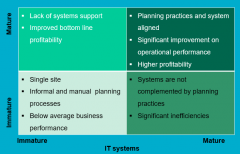![]()
![]()
![]()
Use LEFT and RIGHT arrow keys to navigate between flashcards;
Use UP and DOWN arrow keys to flip the card;
H to show hint;
A reads text to speech;
16 Cards in this Set
- Front
- Back
|
4 different categories of IT systems - Level 1 |
Level 1: Disconnected processes
- Batches - Independent systems – stand alone applications - Data redundancy e.g. supplier address info |
|
|
4 different categories of IT systems - Level 2
|
Level 2: Internal integration
- Datasharing: demand planning module as expert system, advanced algorithms and stats - Shared data across supply chain |
|
|
4 different categories of IT systems - Level 3
|
Level 3: Intracompany integration
– limited external integration - Internal planning data goes to key suppliers - Customers have access to inventory data - Processes & data shared across supply chain |
|
|
4 different categories of IT systems - Level 4
|
Level 4: Multi-enterprise integration
- Customer understands inventory lead-time - First tear Suppliers are aware of end customer demand - Carriers are integrated in planning - Data and processes shared internally & externally |
|
|
4 categories of business processes |
1. Level 1: Disconnected processes 2. Level 2: Internal integration 3. Level 3: Intracompany integration and limited external integration 4. Multi-enterprise integration |
|
|
Linking processes and systems with operational & financial performance |

horizontal: IT, vertical: business processes |
|
|
Four categories of business processes - Level 1
|
- Functional strategies
- Lack of clear, consistent supply chain management processes - No measurements, or measurements not aligned with company objectives |
|
|
Four categories of business processes - Level 2
|
- Integration of some functional information to decrease inventory and improve efficiency - Documented processes that are followed across the entire organization - Key measurements that are used departmentally |
|
|
Four categories of business processes - Level 3
|
- Decisions optimized across the internal supply chain - Sophisticated process that involve all affected internal organizations - Key suppliers and customers included in supply chain planning |
|
|
Four categories of business processes - Level 4
|
- Collaboration across the entire supply chain - Internal and external collaborative supply chain management focus on key service and financial goals - Measures directly linking supply chain results to company goals |
|
|
Decision support systems, analyze data - type 1: use business analytics tools on data from ERP and other systems (4) |
- Queries
- Statistical analysis - Datamining - Online Analytical Processing tools (OLAP) |
|
|
Decision support systems, analyze data - type 2: Use DSS that provides specialized interfaces that display and report based on specific problem being solved (3)
|
- Calculators
- Simulation Artificial Intelligence - Mathematical models and algorithms |
|
|
ERP |
Enterprise resource planning (ERP) is business process management software that allows an organization to use a system of integrated applications to manage the business and automate many back office functions related to technology, services and human resources
|
|
|
APS |
Advanced planning and scheduling refers to a manufacturing management process by which raw materials and production capacity are optimally allocated to meet demand. |
|
|
IT for Supply Chain Excellence (7)
|
- Strategic Network Design
- Tactical planning - Operational planning - Operational execution - Planning horizon - Return on Investment (ROI) - Implementation complexity |
|
|
Achieve an integrated supply chain |

|

